| Maserati Motorcycles | |
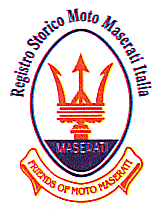 |
If you own a Maserati motorcycle or are interested in this rare marque, you should contact Sig. Giovanni Salmi at FRIENDS OF MOTO MASERATI REGISTRO STORICO MOTO MASERATI ITALIA Via Capramozza 4 40123 Bologna Italia e-mail: info@maseratibikes.it |
| THE NEW WEB SITE IS AT www.maseratibikes.it | |
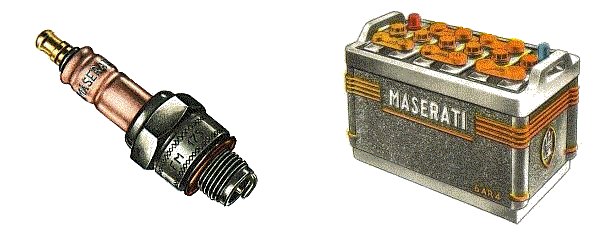 |
|
| Fabbrica Candele Accumulatori Maserati S.p.A. | |
| My sincere thanks to Sig Giovanni Salmi of the Friends of Moto Maserati for providing me with the information on which this page is based. I first laid eyes on a Maserati motorcycle in the Giuseppe Candini workshop in 1998, until then I didn't realise that Maserati had ever made motorcycles and in a way, I was right. Understandably, I assumed that Maserati had at some time produced motorcycles at their factory in Modena. I was wrong! 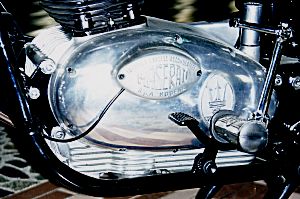 The badge is the same but the maker isn't! In 1939 Maserati moved to a larger factory in Modena, the centre of the Orsi family's operations, with the spark plug factory sited at a separate factory some 2 Km away from the car factory. During and after the war this side of the business, aided by goverment contracts, flourished and in 1947 Società Anonima Fabbrica Candele Accumulatori Maserati was formed with its headquarters in Via Generale Paolucci 165, Modena. 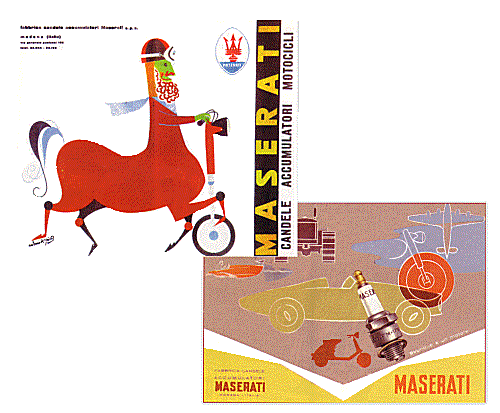 Literature demonstrating the range of products. The company was now expanding fast: thanks largely to an intense advertising campaign in motor cycle, national and provincial magazines and journals, and the product range was extended to include the production of batteries, bulbs, distributor caps and contact sets for the car and motorcycle market. 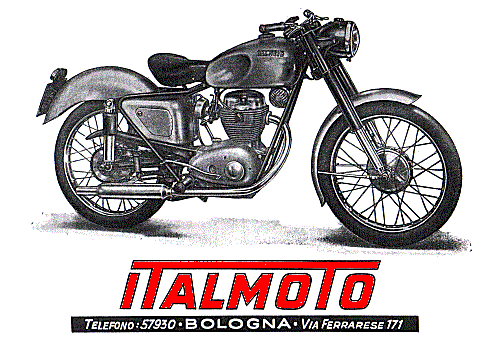 In 1953 all motorcycle production was transferred to the Fabbrica Candele Accumulatori Maserati factory in Via Generale Paolucci 165, Modena. Early production of Maserati motorcycles consisted of the 160cc four-stroke touring bike previously produced by Italmoto but now sporting the Trident logo and renamed the Tipo 160/T4. 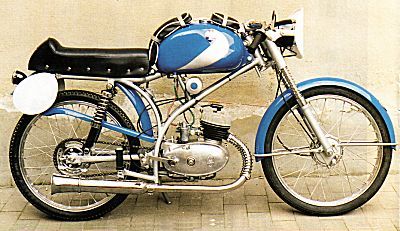 The beautifully styled Tipo 50/T2/SS 'Rospo' The unusual 'back-bone' design of the 50/T2/SS gave rise to its nickname which originated in the premises of Lina and Guido Borri at Via Mazzini 54 in Bologna; the Borris were formerly dealers for Italmoto but now Maserati. When they took delivery of the new model, Lina took one look at the it and exclaimed: "Ma cos'è questo brutto rospo? ("What is this ugly toad?"). From then on, the 50/T2/SS was nicknamed 'Rospo' (toad) and Guido even attached specially designed decals to his bikes depicting a toad 'ready to pounce'. 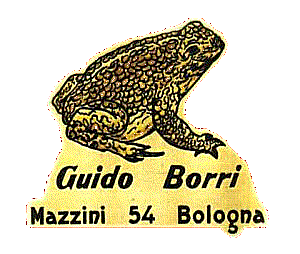 The Guido Borri designed 'Rospo' decal Maserati did not have its own motorcycle racing team, even though this route was proven to have a positive effect on sales, but it did, however, encourage some of its retailers to organise races for its customers. Those races include the ' Giro d'Italia Motociclistico' (The Motorcycle Tour of Italy), the 'Milano-Taranto' (The Milan to Taranto race) and many other local races. At first the Maserati motorcycle business was able to resist strong competition from FIAT, with its small cars that had now invaded the motorcycle market. The Maserati motorcycles had secured an established slice of the market and by 1958 Fabbrica Candele Accumulatori Maserati were producing no fewer than ten different models (shown below). For many young people and Maserati enthusiasts, to own a Maserati motorcycle was a sign of distinction making it preferrable to other marques. Unfortunately all official records of Maserati motorcycle production have been lost but I am sure the REGISTRO STORICO MOTO MASERATI ITALIA would love to know details of any Maserati motorcycles out there. |
| Tipo 50/T2/U - Turismo Uomo Years of production: 1956-1959 Two-stroke single cylinder 49.635 cc engine Bore 40mm and stroke 39.5mm Compression ratio 8.0:1 Power output 2.0 bhp @ 6000 rpm Maximum revs 6500 rpm Dell'Orto T1 13 SA carburettor 3-speed gearbox Maximum speed 50/55 kph Dry weight 52 kg |
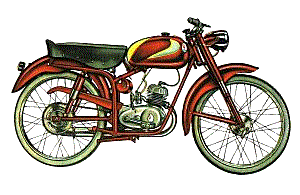 |
| Tipo 50/T2/D - Turismo Donna Years of production: 1956-1959 Two-stroke single cylinder 49.635 cc engine Bore 40mm and stroke 39.5mm Compression ratio 8.0:1 Power output 2.0 bhp @ 6000 rpm Maximum revs 6500 rpm Dell'Orto T1 13 SA carburettor 3-speed gearbox Maximum speed 50/55 kph Dry weight 50 kg |
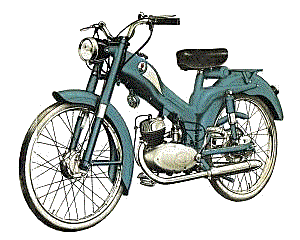 |
| Tipo 50/T2/S - Sport Years of production: 1956-1959 Two-stroke single cylinder 49.635 cc engine Bore 40mm and stroke 39.5mm Compression ratio 10.0:1 Power output 2.4 bhp @ 6700 rpm Maximum revs 7000 rpm Dell'Orto T4 13 SA carburettor 3-speed gearbox Maximum speed 60/65 kph Dry weight 52 kg |
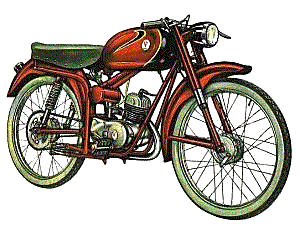 |
| Tipo 50/T2/SS - Super Sport Years of production: 1956-1959 Two-stroke single cylinder 49.635 cc engine Bore 40mm and stroke 39.5mm Compression ratio 12.0:1 Power output 2.82 bhp @ 6700 rpm Maximum revs 7300 rpm Dell'Orto UA 16 S carburettor 3-speed gearbox Maximum speed 70/75 kph Dry weight 49 kg |
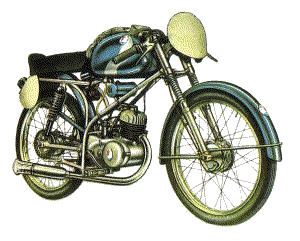 |
| Tipo 50/T2/MT - Ciclocarro Years of production: 1956-1959 Two-stroke single cylinder 49.635 cc engine Bore 40mm and stroke 39.5mm Compression ratio 8.0:1 Power output 2.0 bhp @ 6000 rpm Maximum revs 6500 rpm Dell'Orto T1 13 SA carburettor 3-speed gearbox Maximum speed 38/40 kph Dry weight 115 kg |
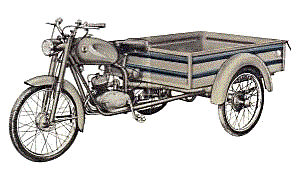 |
| Tipo L/75/T2 - Turismo Lusso Years of production: 1957-1959 Two-stroke single cylinder 74 cc engine Bore 45.5mm and stroke 45.5mm Compression ratio ? Power output 4.5 bhp @ 6500 rpm Maximum revs 7000 rpm Dell'Orto ? carburettor 3-speed gearbox Maximum speed 80 kph Dry weight 65 kg |
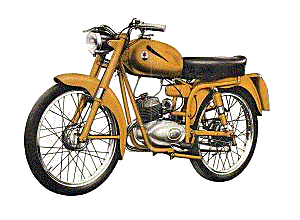 |
| Tipo L/125/T2 - Turismo Lusso Years of production: 1954-1959 Two-stroke single cylinder 123 cc engine Bore 52mm and stroke 58mm Compression ratio 6.5:1 Power output 4.8 bhp @ 5000 rpm Maximum revs 5000 rpm Dell'Orto ? carburettor 3-speed gearbox Maximum speed 60/65 kph Dry weight 80 kg |
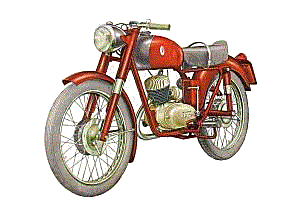 |
| Tipo 125/GT/Super Years of production: 1954-1959 Two-stroke single cylinder 123 cc engine Bore 52mm and stroke 58mm Compression ratio 7.5:1 Power output 7.25 bhp @ 5500 rpm Maximum revs 6000 rpm Dell'Orto ? carburettor 4-speed gearbox Maximum speed 90/95 kph Dry weight 86 kg |
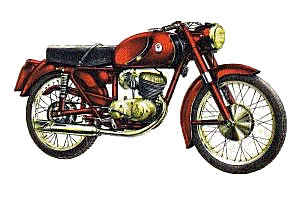 |
| Tipo L/160/T4 - Turismo Lusso Years of production: 1954-1959 Four-stroke single cylinder 158 cc engine Bore 60mm and stroke 56mm Compression ratio 6.5:1 Power output 7.5 bhp @ 5500 rpm Maximum revs 6000 rpm Dell'Orto ? carburettor 4-speed gearbox Maximum speed 100/105 kph Dry weight 112 kg |
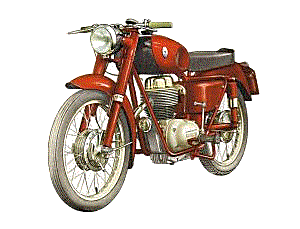 |
| Tipo 250/T4 - Gran-Turismo Lusso Years of production: 1958-1959 Four-stroke single cylinder 246.5 cc engine Bore 70mm and stroke 64mm Compression ratio 6.5:1 Power output 12.5 bhp @ 5350 rpm Maximum revs 5900 rpm ell'Orto ? carburettor Dual ignition system 4-speed gearbox Maximum speed 115/120 kph Dry weight 150 kg |
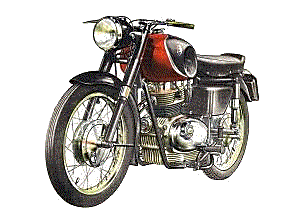 |
| MASERATI MOTORCYCLE PRODUCTION 1953 to 1960 | ||||
| MODEL | Years of production | Cubic Capacity | Horsepower | Gears |
| 125/T2 | 1953-1956 | 123 cc | 4.8 | 3 |
| 160/T4 | 1953-1959 | 158 cc | 7.5 | 4 |
| 125/TV | 1953-1958 | 123 cc | 6.0 | 4 |
| 160/T4/TL | 1955 | 158 cc | 7.5 | 4 |
| 125/T2/TL | 1955 | 123 cc | 4.8 | 3 |
| 175/T4/S | 1955 | 175 cc | 15.0 | 4 |
| 250/T4/GT | 1955 | 246.2 cc | 12.5 | 4 |
| 125/GTS | 1957 | 123 cc | 7.2 | 4 |
| 50/T2/U | 1956 | 49.6 cc | 2.4 | 3 |
| 50/T2/D | 1956 | 49.6 cc | 2.0 | 3 |
| 50/T2/S | 1956 | 49.6 cc | 3.0 | 3 |
| 50/T2/SS | 1956 | 49.6 cc | 3.0 | 3 |
| L 75/T2 | 1958 | 74 cc | 4.5 | 3 |
| 125/LE | 1959 | 123 cc | 5.3 | 3 |
| 50/T2/MT | 1957 | 49.6 cc | 2.0 | 2 |
|
To enter Enrico's Maserati Pages CLICK HERE! Copyright: Giovanni Salmi - © 2002-2005. All rights reserved. |